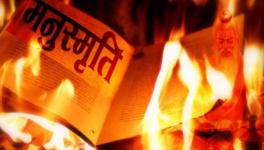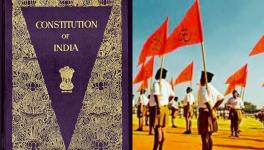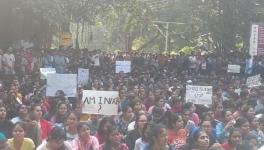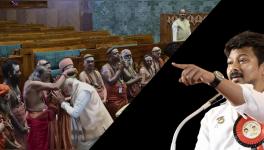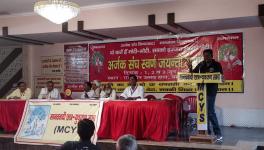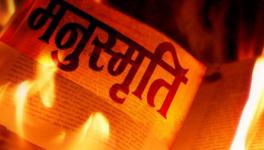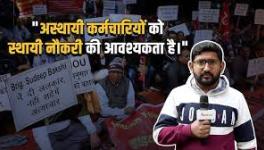UP: 13 BHU Students Arrested, Interrogated by ATS Over Alleged Burning of Manusmriti
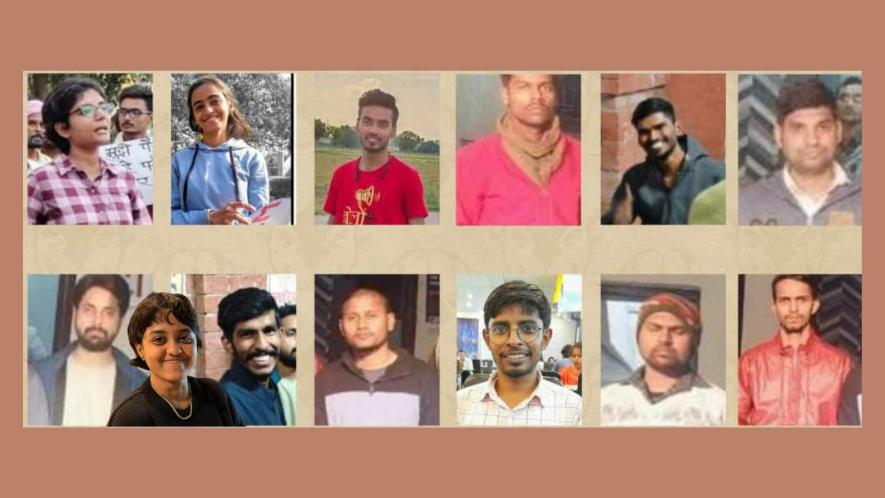
On December 26, 2024, 13 individuals, including three females, affiliated with the Bhagat Singh Students Morcha (BSM), a Marxist student organization at Banaras Hindu University (BHU), were arrested by the Lanka Police Station, Varanasi and sent to 14-day judicial custody by the Varanasi District court. This action followed a discussion held on December 25, which marked Manusmriti Dahan Divas, commemorating Dr. B.R. Ambedkar’s historic burning of the Manusmriti in 1927. The discussion, which took place at the university’s Arts Faculty, was disrupted by university officials and security staff, leading to a scuffle between the students and security guards.
The 13 individuals—nine students and four alumni—are currently being held in District Jail, Chaukaghat. As they were shifted to jail, the students raised slogans like “Manusmriti Murdabad, Inquilab Zindabad, Jai Bhim,” and “Stop violence against students,” emphasizing their opposition to the state’s repression.
The jailed students were also interrogated by the Anti-Terrorism Squad (ATS)
Background
On December 25, a discussion was organized by the Bhagat Singh Students Front at BHU on the occasion of Manusmriti Dahan Divas. The significance of this historic day lies in the fact that Dr. B.R. Ambedkar had burned the Manusmriti on this day in 1927. Members of the Bhagat Singh Students Front had gathered to discuss this topic. During the discussion, the guards of the BHU Proctorial Board came and misbehaved with the students, dragging them to the Proctorial Board office. The students were locked up there around 7:30 PM. Later, on December 26, 2024, an FIR with serious charges was filed against 13 members of the BSM, and they were arrested and sent to 14-days of judicial custody.
As per report, during this incident, the students were physically assaulted, their clothes were torn, and their glasses were broken. Any student who came to help them was also pushed, shoved, and beaten. BHU guards and the Varanasi police threatened the students with various kinds of threats, including ruining their future and warnings of retaliation. All of this took place during the ‘Manusmriti Dahan Divas’ discussion held at the Arts Faculty, BHU.
It is alleged that the police and Proctorial Board members beat up the arrested students. They were kept locked in the Lanka police station overnight and were not allowed to meet their lawyers. Reports suggest that the students suffered serious injuries during this time. Their clothes were torn, and their glasses were broken. Students who went to the Proctorial Board for help were also detained after being pushed and assaulted.
FIR registered under the serious provisions of BNS, 2023
An FIR (No. 523/2024) has been filed by the Lanka Police Station against the 13 students under sections 132 (assault or criminal force to deter a public servant from the discharge of their duty), 121(2) (causing grievous hurt to a public servant), 196(1) (promoting enmity between different groups on grounds of religion, race, place of birth, residence, language, etc.), 299 (deliberate and malicious acts intended to outrage religious feelings of any class by insulting its religion or religious beliefs), 190 (unlawful assembly for any offence committed by the group), 191(2) (rioting), 115(2) (voluntarily causing hurt to another person), and 110 (attempt to commit culpable homicide) of the Bharatiya Nyaya Sanhita, 2023.
According to the FIR, registered on the written complaint of BHU Security Officer Omprakash Tiwari and H.A. Zaidi, it states, “On 25.12.2024, at 5:30 pm, 20-25 students associated with Bhagat Singh Chhatra Morcha were sitting near the Arts Faculty Square and lighting a fire. Confidential information was received that these individuals were celebrating Manusmriti Dahan Diwas that day and planning to burn copies of Manusmriti. Acting on this information, I, Omprakash Tiwari, Security Officer, along with my colleagues Hasan Abbas Zaidi (Assistant Security Officer), Security Inspector Bhaiyalal, and Proctorial Board members Prof. Fate Bahadur Singh, Dr. Sujit Kumar Singh, Dr. Ajay Yadav, Dr. Amresh Singh, Dr. Upendra Kumar, Dr. Divya Bharti, Dr. Ravi Shankar Mishra, along with female security guards Shipra Mishra, Shikha Mishra, and other security personnel, reached the spot and attempted to pacify them. However, the following students misbehaved and pushed us. After this, I was warned that if we took any action against the rules, further action would be taken.”
“The following students did not heed the warning and started pushing and hitting me and other people present with me, obstructing the work of the public government, due to which two of my women security personnel Shipra Mishra and Shikha Mishra got seriously injured and fainted on the spot. They are being treated at BHU Trauma Center. Their actions are having an adverse effect on maintaining harmony. A total of 13 students have been identified in this incident” as per FIR.
The arrested students include Mukesh Kumar, Sandeep Jaiswal, Amar Sharma, Arvind Pal, Anupam Kumar, Lakshman Kumar, Avinash, Arvind, Shubham Kumar, Adarsh, Ipsita Agarwal, Siddhi Tiwari, and Katyayani B. Reddy. These students have been charged under the provisions, which carry a provision for up to 10 years of imprisonment.
The FIR dated 26.12.2024 can be read here
BSM said, suppression done at the behest of Brahmanical and Hindutva forces
The President of Bhagat Singh Students Front, Akanksha Azad, termed the action taken against the students as “suppression done at the behest of Brahmanical and Hindutva forces.” While dismissing the accusations against BSM, Akanksha said that, “We deny all the fabricated allegations raised against us by the university-police nexus. They want to crush dissent and our organization. In fact, they are suppressing every civil organization that questions this RSS fascist government” as the Observer Post Reported
She said, “We are the heirs of Baba Saheb and Bhagat Singh’s thoughts. Whatever efforts are made to suppress our voice, we will stand firm even stronger.”
Akanksha alleged that the BHU administration and police took this action under pressure from fascist forces. She stated, “Sending students to jail for discussing texts like Manusmriti is like mocking democracy. Manusmriti gives women and Dalits a status worse than that of animals, and such oppressive actions cannot crush their dreams and ideas.”
The Bhagat Singh Students Front has demanded the immediate release of the arrested students. They called for the false report to be annulled immediately and FIRs to be filed against the policemen and BHU guards who used violence against the students. The organization said, “Our courage and dreams cannot be suppressed. The arrest of students on Manusmriti Day has once again proven that freedom of expression is under threat. But the people of Banaras, who have always been a land of knowledge, dialogue, and ideas, will not remain silent against this injustice.”
Akanksha claimed that the students’ mobile phones were seized, and they were not allowed to inform their families, which is a clear violation of Supreme Court and Human Rights Commission directives. On December 26, the students were presented before the remand court and sent to jail. The FIR filed includes very serious charges. This incident not only violates the students’ rights but also openly disregards judicial processes and human rights.
FIR reveals no serious allegations against students, only ideological dissent
The FIR filed in connection with the December 25 incident at BHU highlights an ideological disagreement between the students and the administration, rather than any serious criminal behavior. The report indicates that students associated with Bhagat Singh Chhatra Morcha were peacefully engaged in a discussion to commemorate Manusmriti Dahan Divas. Following confidential information, police and security officers intervened, but the situation escalated into a minor physical altercation. The FIR does not point to any major criminal activity, with injuries to security personnel attributed to the scuffle.
While the FIR claims that the students’ actions impacted public harmony, it seems more like an effort to suppress student activism rather than address any serious offense. The students were charged under serious provisions, but the allegations appear inflated, raising concerns about attempts to silence dissent.
What is Manusmriti?
Manusmriti, often a topic of controversy, especially in the context of women and marginalized communities, is seen as a symbol of caste and gender discrimination in Indian society. Dr. B.R. Ambedkar famously burned it in 1927 as an act of protest. Manusmriti is an ancient Hindu religious text, consisting of 12 chapters and over 2,600 verses. It was first translated into English in 1776. Maharishi Manu, considered the author, is regarded as the spokesperson for the “human constitution” and the architect of societal norms. These laws, known as “Manuism,” laid down controversial rules regarding women’s rights and freedoms.
Controversial views on women
Manusmriti outlines a societal structure where women are seen as subordinate to their father, husband, or son, and can never be independent. In Chapter 5, Verse 148, it states that after marriage, a woman should remain under the protection of her husband or sons after his death. It further asserts that women have a nature to “seduce men” and should be kept under strict surveillance.
The text also contains statements such as, “Do not marry a woman with red hair or eyes, one with extra limbs, who is often ill, or one from a low caste.” It advises against marriage to a woman whose name refers to terror, rivers, trees, or snakes. Additionally, it says that Brahmins should not eat in the presence of menstruating women, pigs, dogs, or eunuchs.
These rules deny the equality and freedom of women and attempt to subjugate them under patriarchal control. The Manusmriti has long been a source of debate, and its controversial nature highlights the ongoing fight for equality and freedom in society.
Dr. Ambedkar’s protest against Manusmriti
Due to its oppressive views, Dr. B.R. Ambedkar burned the Manusmriti in 1927, condemning it as a text that violated the rights of Dalits and women. However, some still regard it as a guiding text for societal welfare, albeit ignoring its controversial aspects. Historian Kurundkar has provided insights into Manusmriti’s structure, explaining that the text was composed around 200-300 years before the birth of Christ. The first chapter covers topics like the creation of nature, the four yugas (ages), the four varnas (classes), and the greatness of Brahmins. Subsequent chapters address topics like celibacy, marriage, household duties, and various forms of punishment.
The fifth chapter, which is particularly controversial, discusses the duties of women, their purity, and their place in society. The book also covers the roles of saints, kings, criminal justice, and the praise of the Vedas in the final chapters.
Controversial aspects of Manusmriti
Dalit scholar Rajiv Lochan explains that Manusmriti discusses rights, crimes, justice, and punishment in a manner akin to the modern Indian Penal Code (IPC) and Criminal Procedure Code (CRPC). When the British arrived in India, they saw Manusmriti as the Hindu equivalent of Sharia law and began using it as a reference in legal matters. This led to the belief that Manusmriti was the Hindu “holy book.”
Lochan suggests that Brahmins, facing a decline in their power due to the rise of Buddhist teachings, revived Manusmriti to reassert their dominance. It propagated the myth that Brahmins were superior in society, while others faced harsher punishments. The text even asserts that a woman’s welfare can only be achieved through the welfare of a man, and that women should have no religious rights.
The British and Manusmriti’s influence
During British rule, Manusmriti became a subject of widespread discussion due to its use in legal matters. William Jones’ English translation of the text brought it into public knowledge. Mahatma Jyotirao Phule was one of the first to challenge Manusmriti, critiquing Brahmins and merchants while highlighting the dire conditions of Dalits and marginalized groups.
When Ambedkar burned the Manusmriti
On July 25, 1927, Dr. Ambedkar publicly burned Manusmriti at Mahad in Maharashtra. In his book Philosophy of Hinduism, Ambedkar writes, “Manu advocated the four-fold varna system, laying the foundation of caste-based discrimination. While Manu did not create the caste system, he certainly sowed its seeds.”
Ambedkar also recorded his opposition to Manusmriti in his works Who Were the Shudras? and The End of Caste. At that time, Dalits and women were denied the right to live a dignified life, and the caste system thrived on the Brahminical supremacy. Ambedkar described the caste system as a multi-story building with no stairs, where people are divided based on their work, and the lower castes are relegated to the bottom with no possibility of advancement.
The legacy of Ambedkar’s protest
After Ambedkar’s act of burning the Manusmriti, similar protests occurred across the country, leading to discussions in newspapers about the text’s influence on Indian society. Even after India’s independence, the debate continued. In 1970, Kanshi Ram formed BAMCEF, declaring that Indian society was divided between the “Manuwadi” (followers of Manu) and the “Mulnivasi” (indigenous people).
Get the latest reports & analysis with people's perspective on Protests, movements & deep analytical videos, discussions of the current affairs in your Telegram app. Subscribe to NewsClick's Telegram channel & get Real-Time updates on stories, as they get published on our website.











